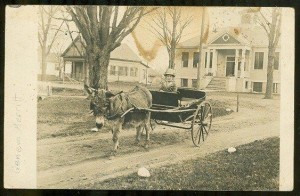We have been extremely fortunate to have had surveys [of our graveyards] made at different times over the years. Stones that were present in the 1907 survey by Byron Ruggles are not always still to be found. If a stone breaks and falls over, it doesn’t take long for nature to do its job of hiding it forever under leaves and grass that turn to dirt. People who are interested enough to carefully probe can sometimes find these stones and bring them back to light. The following was written by Byron Ruggles in 1907.
“To the Editor of the Standard;
During the summer of 1907 I visited all of the thirteen graveyards in town and copied the inscriptions on all of the stones I found. Some of the yards are so neglected and overrun with trees and weeds, brush, briars, vines and weeds that I am not sure that I found all of the gravestones, some being broken and down and covered with leaves and brush. Two or three of the yards are in fairly good condition. Two or three are barely passable and others are sadly neglected.
All of the yards are fenced and all but three or four with stone walls, but the walls are not all in a good state of repair. Eight of the yards have stones with dates previous to 1800, three dates at 1800 and the other two started at 1832 and 1844.
There are also from two to seven graves in each of six other places in town with eight or ten lettered stones in all of them I have been told but only a part of them can be found now. Only one of these family lots was ever fenced.
The smallest of the thirteen yards has 19 lettered stones, the next larger has 27 and the others range from 52 up to over 600 in the yard or cemetery at Hartland Village.
I found 2043 graves with stones having inscriptions and counted and estimated 431 graves that never had lettered stones.
Of the lettered stones, the oldest is the wife of Moses Barnes dated 1768. The oldest person is Grace Totman, died in 1832 aged 102 years.
Some of the inscriptions are quite short and some more elaborate. Among the later are those of Judge Elihu Luce, Dr John Harding, Griffin who was killed by the breaking down of a bridge, Elisha Gallup, the founder of the Vermont Medical College (this should be Joseph. CYM), Ephraim Carey, Peter Gilson and Granger Marcy, revolutionary patriots, and Capt. Timothy Lull, the first settler in town.
One of the shortest inscriptions reads: Frederick Remington, on a nicely polished Ascutney granite stone, and another on a marble stone is just Dr. Daniel Hall.
Some of the older gravestones are of hewed slate and soapstone, later sawed slate and soapstone, marble of five varieties, granite of eight varieties and sandstone and zinc.
On the more than two thousand stones there are 345 mottoes, quotations and items of original and selected poetry, from which I give a selection;
“She has left us to dwell with the angels on high,
She has gone to her home beyond the blue sky,
She has gone with the holy, the perfect to dwell,
She has gone and has bade us a final farewell”
Mr Ruggles has many more quotes but I would encourage you to go find your own. Beautiful fall days are a wonderful time to explore your local cemeteries and put yourself back in time. Finding a gravestone can be like opening a book to the story that lies within. The internet, the Clerks office and the Historical Society are great places to discover the life of the person you have just met. With that in mind, I decided to see what I could find out about the Aldrich family that for so many years made their home in one of the most beautiful parts of Hartland.
Extracted from the Fall 2008 Hartland Historical Society Newsletter.










